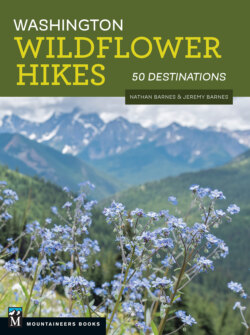Читать книгу Washington Wildflower Hikes - Nathan Barnes - Страница 14
На сайте Литреса книга снята с продажи.
Leave No Trace and Have Zero Impact
ОглавлениеMany of the hikes in this book visit mountain meadows brimming with wildflowers that may be tempting to explore. Most hikers know not to pick the flowers so that others can enjoy the color they bring to a hike. But many hikers may not realize that these meadows are extremely fragile and easily damaged, especially at higher alpine elevations. Errant feet can cause damage that will take the landscape many years to recover from. With so many people exploring many of these trails every year, it is critical to treat these areas respectfully, lest they be loved and enjoyed right into oblivion. It takes only a brief visit to popular destinations like Mount Rainier’s Paradise Meadows to see how easily the flowers can be trampled out of existence.
Attempt a zero-impact approach when hiking through sensitive and fragile areas. Hike in small groups, stick to the trail and rocks, and use backcountry toilets where available. Camp only at existing sites, and practice Leave No Trace (LNT) principles.
If you are not familiar with LNT principles, take some time to review this philosophy on the Leave No Trace Center for Outdoor Ethics website, https://lnt.org/learn/7-principles. The goal is to leave no physical evidence of your time on these trails, which is particularly important in wilderness areas.
Two particularly important points related to minimizing your impact on trails involve switchbacks and the landscape itself. Do not cut switchbacks. This practice destabilizes the slope and makes it more likely that large sections of trail will be destroyed. There is never a need to take a shortcut; after all, spending time in the wild is the whole reason for hiking!
Do not alter the landscape. Leave it like you found it and pack out what you bring in. Don’t carve your initials into logs, draw on rocks, cut down trees, pick wildflowers, or otherwise mar the environment.
